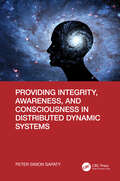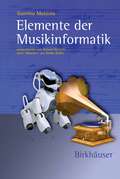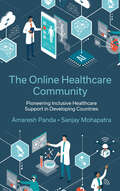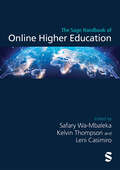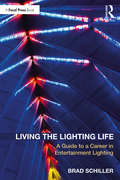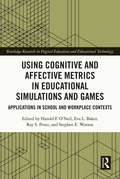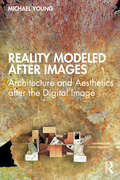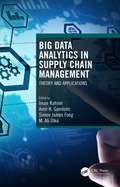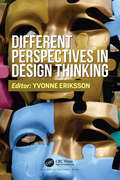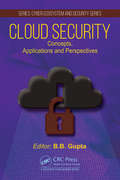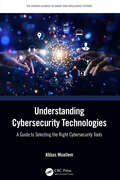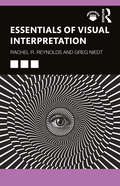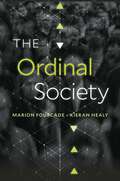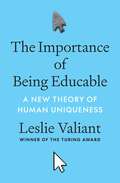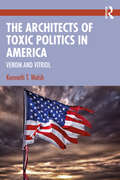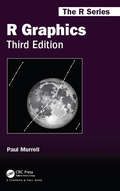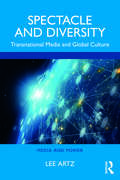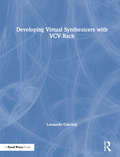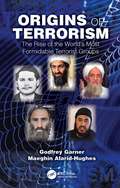- Table View
- List View
Providing Integrity, Awareness, and Consciousness in Distributed Dynamic Systems
by Peter Simon SapatyThe ideas of this book originate from the mobile WAVE approach which allowed us, more than a half century ago, to implement citywide heterogeneous computer networks and solve distributed problems on them well before the internet. The invented paradigm evolved into Spatial Grasp Technology and resulted in a European patent and eight books. The volumes covered concrete applications in graph and network theory, defense and social systems, crisis management, simulation of global viruses, gestalt theory, collective robotics, space research, and related concepts. The obtained solutions often exhibited high system qualities like global integrity, distributed awareness, and even consciousness. This current book takes these important characteristics as primary research objectives, together with the theory of patterns covering them all. This book is oriented towards system scientists, application programmers, industry managers, defense and security commanders, and university students (especially those interested in advanced MSc and PhD projects on distributed system management), as well as philosophers, psychologists, and United Nations personnel.
Elemente der Musikinformatik
by Guerino MazzolaDieses Lehrbuch stellt eine Einführung in die noch junge Disziplin der Musikinformatik dar. Es beginnt mit einer Übersicht über die gegenwärtige Entwicklung der Musik aus der Wechselwirkung zwischen Technologie und Komposition. Darauf aufbauend werden Kodierung und Programmierung musikalischer Objekte für Komposition, Analyse und Interpretation besprochen, sowie Standards und Darstellungsmethoden, wie: MIDI, Musik-N, Fourier, FM, Wavelets, Physical Modeling und Denotatoren. Eine vertiefte Diskussion erfährt dabei der FFT-Algorithmus und natürlich das Kompressionsverfahren MP3. Anschließend werden Plattformen für die computergestützte Analyse, Komposition und Interpretation vorgestellt, darunter RUBATO, MAX und Presto. Darauf folgt eine Einführung in Methoden der Navigation im Begriffsraum der Musik. Abschließend wird die Perspektive einer verteilten globalen Musikkultur diskutiert, wie sie sich etwa durch den iPod, sowie Internet-basierte Musikdistribution, -produktion und -komposition abzeichnet.
The Online Healthcare Community: Pioneering Inclusive Healthcare Support in Developing Countries
by Amaresh Panda Dr. Sanjay MohapatraThe shift from in-person to online health services has now become a driving force in delivering efficient healthcare, especially in developing countries where this need is imperative. The Online Health Community (OHC) serves as a virtual platform where individuals, including patients, medical professionals, caregivers, and families, can learn about illnesses, offer support, and connect with others in similar situations. In The Online Healthcare Community: Pioneering Inclusive Healthcare Support in Developing Countries, authors Amaresh Panda and Sanjay Mohapatra lay the foundation for exploring virtual healthcare practices in India by presenting an overview of the online healthcare concept within the Online Healthcare Community (OHC). They begin by developing a comprehensive literature review, evaluating existing studies, identifying key variables, and tracing the systematic evolution spread over years for OHC. Chapters go on to employ an empirical-deductive approach with a quantitative orientation to evaluate relationships among variables, focusing on stakeholder activities within the online healthcare domain. Their findings offer industry insights and highlight the integral role OHC will play in the future of healthcare. Essential for students, researchers, and healthcare professionals keen on understanding the changing healthcare landscape, this work explores the shift to virtual healthcare emphasizing OHC's engagement, expertise sharing, and capacity for industry transformation, especially across tech-driven nations such as India.
The Sage Handbook of Online Higher Education
by Safary Wa-Mbaleka Kelvin Thompson Leni CasimiroThe SAGE Handbook of Online Higher Education presents a cutting-edge collection of 50 essays that explores the rapidly evolving landscape of online teaching and learning in higher education. Assembled and contributed by a team of leading experts, the Handbook adopts a uniquely holistic approach to examining the needs of online education. Chapters bring together voices from diverse and international backgrounds to provide insights applicable to a broad range of contexts, and present practical strategies for planning, delivering quality online higher education. The handbook covers a wide range of topics, including online pedagogy, instructional design, student engagement, technological innovation, assessment, leadership, and the developing role of online education in the context of broader societal and cultural shifts. The SAGE Handbook of Online Higher Education is an essential resource for educators, researchers, policymakers, and practitioners who seek to understand and shape the future of higher education in the digital age. Section 1: Fundamentals of Online Education Section 2: Online Education Around the World Section 3: Online Instructional Design Section 4: Online Instructional Delivery Section 5: Instructional Technology for Online Education Section 6: Online Education Administration and Management Section 7: Student Support Services
The Sage Handbook of Online Higher Education
by Safary Wa-Mbaleka Kelvin Thompson Leni CasimiroThe SAGE Handbook of Online Higher Education presents a cutting-edge collection of 50 essays that explores the rapidly evolving landscape of online teaching and learning in higher education. Assembled and contributed by a team of leading experts, the Handbook adopts a uniquely holistic approach to examining the needs of online education. Chapters bring together voices from diverse and international backgrounds to provide insights applicable to a broad range of contexts, and present practical strategies for planning, delivering quality online higher education. The handbook covers a wide range of topics, including online pedagogy, instructional design, student engagement, technological innovation, assessment, leadership, and the developing role of online education in the context of broader societal and cultural shifts. The SAGE Handbook of Online Higher Education is an essential resource for educators, researchers, policymakers, and practitioners who seek to understand and shape the future of higher education in the digital age. Section 1: Fundamentals of Online Education Section 2: Online Education Around the World Section 3: Online Instructional Design Section 4: Online Instructional Delivery Section 5: Instructional Technology for Online Education Section 6: Online Education Administration and Management Section 7: Student Support Services
Living the Lighting Life: A Guide to a Career in Entertainment Lighting
by Brad SchillerLiving the Lighting Life provides practical tools and advice for a successful career in entertainment lighting. This easy-to-navigate guide offers real-world examples and documentation from the author and key industry experts, giving readers a comprehensive overview of the lighting life. The book provides insight on: Different job opportunities in the entertainment lighting industry; Business procedures, contracts, time sheets, and invoices; Tips on self-promotion, networking, and continual learning; The lighting lifestyle, healthy living, and work-related travel; Maintaining and developing creativity to provide innovative lighting and solutions. With insightful interviews from industry veterans, Living the Lighting Life is a key navigational resource for anyone considering a career in entertainment lighting or just starting out.
Using Cognitive and Affective Metrics in Educational Simulations and Games: Applications in School and Workplace Contexts (Routledge Research in Digital Education and Educational Technology)
by Harold F. O'NeilPresenting original studies and rich conceptual analyses, this volume explores how cognitive and affective metrics can be used to effectively assess, modify, and enhance learning and assessment outcomes of simulations and games used in education and training.The volume responds to the increasing use of computer-based simulations and games across academic and professional sectors by bringing together contributions from different research communities, including K-12 and postsecondary education, medical, and military contexts. Drawing on empirical results, the chapter authors focus on the design and assessment of educational simulations and games. They describe how quantitative and qualitative metrics can be used effectively to evaluate and tailor instructional resources to the cognitive and affective needs of the individual learner. In doing so, the volume enhances understanding of how games and simulations can intersect with the science of learning to improve educational outcomes. Given its rigorous and multidisciplinary approach, this book will prove an indispensable resource for researchers and scholars in the fields of educational assessment and evaluation, educational technology, military psychology, and educational psychology.
Reality Modeled After Images: Architecture and Aesthetics after the Digital Image
by Michael YoungReality Modeled After Images: Architecture and Aesthetics after the Digital Image explores architecture’s entanglement with contemporary image culture. It looks closely at how changes produced through technologies of mediation alter disciplinary concepts and produce political effects. Through both historical and contemporary examples, it focuses on how conventions of representation are established, maintained, challenged, and transformed. Critical investigations are conjoined with inquiries into aesthetics and technology in the hope that the tensions between them can aid an exploration into how architectural images are produced, disseminated, and valued; how images alter assumptions regarding the appearances of architecture and the environment.For students and academics in architecture, design and media studies, architectural and art history, and related fields, this book shows how design is impacted and changed by shifts in image culture, representational conventions and technologies.
Big Data Analytics in Supply Chain Management: Theory and Applications
by Iman Rahimi, Amir H. Gandomi, Simon James Fong, and M. Ali ÜlküIn a world of soaring digitization, social media, financial transactions, and production and logistics processes constantly produce massive data. Employing analytical tools to extract insights and foresights from data improves the quality, speed, and reliability of solutions to highly intertwined issues faced in supply chain operations.From procurement in Industry 4.0 to sustainable consumption behavior to curriculum development for data scientists, this book offers a wide array of techniques and theories of Big Data Analytics applied to Supply Chain Management. It offers a comprehensive overview and forms a new synthesis by bringing together seemingly divergent fields of research. Intended for Engineering and Business students, scholars, and professionals, this book is a collection of state-of-the-art research and best practices to spur discussion about and extend the cumulant knowledge of emerging supply chain problems.
Different Perspectives in Design Thinking
by Yvonne ErikssonGlobalization and digitalization are buzz words in contemporary society. They affect both our private and our professional lives. Society has become more diverse with easier access to information and to virtual platforms that gives us opportunity to be in touch with colleagues, friends, family, etc. at any time. A complex environment is emerging wherein internet of things and big data are being integrated with products, production systems, healthcare, and daily activity and play an important part in decision making. This has an impact on future designs and the role of designers. Responsible designers with a holistic perspective are needed.The book highlights several aspects of design thinking such as Information Design and Critical Design. The meaning of culture, gender and disabilities are also discussed. The functions of Information Design are changing from ‘showing the way’, instruction manuals and graphic design. It will affect among others, healthcare technology, smart products and Industry 4.0. Design thinking perspective that includes users from the entire chain and from the producer to the end user of the product or service, is needed. This will also require gender and culture issues to be taken into consideration in designing products and services. Design thinking methods and critical aspects of design will contribute to an inclusive society.
Cloud Security: Concepts, Applications and Perspectives (Cyber Ecosystem and Security)
by Brij B GuptaCloud computing is an indispensable part of the modern Information and Communication Technology (ICT) systems. Cloud computing services have proven to be of significant importance, and promote quickly deployable and scalable IT solutions with reduced infrastructure costs. However, utilization of cloud also raises concerns such as security, privacy, latency, and governance, that keep it from turning into the predominant option for critical frameworks. As such, there is an urgent need to identify these concerns and to address them.Cloud Security: Concepts, Applications and Perspectives is a comprehensive work with substantial technical details for introducing the state-of-the-art research and development on various approaches for security and privacy of cloud services; novel attacks on cloud services; cloud forensics; novel defenses for cloud service attacks; and cloud security analysis. It discusses the present techniques and methodologies, and provides a wide range of examples and illustrations to effectively show the concepts, applications, and perspectives of security in cloud computing. This highly informative book will prepare readers to exercise better protection by understanding the motivation of attackers and to deal with them to mitigate the situation. In addition, it covers future research directions in the domain. This book is suitable for professionals in the field, researchers, students who are want to carry out research in the field of computer and cloud security, faculty members across universities, and software developers engaged in software development in the field.
Understanding Cybersecurity Technologies: A Guide to Selecting the Right Cybersecurity Tools (The Human Element in Smart and Intelligent Systems)
by Abbas MoallemCyberattacks on enterprises, government institutions, and individuals are exponentially growing. At the same time, the number of companies, both small and large, offering all types of solutions has been increasing too. Since companies rely on technological solutions to protect themselves against cyberattacks, understanding and selecting the right solutions among those offered presents a significant challenge for professionals, company executives, and newcomers to the cybersecurity field.FEATURES Presents descriptions for each type of cybersecurity technology and their specifications Explains applications, usages, and offers case studies to enhance comprehension Offers an easy-to-understand classification of existing cybersecurity technologies Provides an understanding of the technologies without getting lost in technical details Focuses on existing technologies used in different solutions, without focusing on the companies that offer these technologies This book is intended to help all professionals new to cybersecurity, students, and experts to learn or educate their audiences on the foundations of the available solutions.
Crime Science and Digital Forensics: A Holistic View
by Anthony C. IjehThis volume is a collation of articles on counter forensics practices and digital investigative methods from the perspective of crime science. The book also shares alternative dialogue on information security techniques used to protect data from unauthorised access and manipulation. Scandals such as those at OPCW and Gatwick Airport have reinforced the importance of crime science and the need to take proactive measures rather than a wait and see approach currently used by many organisations. This book proposes a new approach in dealing with cybercrime and unsociable behavior involving remote technologies using a combination of evidence-based disciplines in order to enhance cybersecurity and authorised controls. It starts by providing a rationale for combining selected disciplines to enhance cybersecurity by discussing relevant theories and highlighting the features that strengthen privacy when mixed. The essence of a holistic model is brought about by the challenge facing digital forensic professionals within environments where tested investigative practices are unable to provide satisfactory evidence and security. This book will be of interest to students, digital forensic and cyber security practitioners and policy makers. It marks a new route in the study of combined disciplines to tackle cybercrime using digital investigations and crime science.
Essentials of Visual Interpretation
by Rachel R Reynolds Greg NiedtEssentials of Visual Interpretation explains how to talk and write critically about visual media and to examine how evolving visual environments, media, and technologies affect human selfunderstanding and culture formation.Lively and accessibly written chapters provide a solid foundation in the tools and ideas of visual meaning, familiarizing readers with a growing, cross-cultural subfield, and preparing them to pursue thoughtful work in a variety of related disciplines. The authors include rich examples and illustrations—ranging from cave paintings to memes, from optical science to visual analytics, from ancient pictographs to smart phones—that engage students with the fascinating complexity of visual interpretation. Each chapter introduces students to key terms and concepts relevant to visual analysis, with ideas for short individual or group exercises to enhance understanding.The book is ideal as a primer in visual analysis and visual communication for students in courses within communication studies, cultural studies, digital humanities, semiotics, media studies, and visual anthropology.Online support materials include multimedia activities for students and links to additional resources for students and instructors.
Instructional-Design Theories and Models, Volume IV: The Learner-Centered Paradigm of Education
by Charles M. Reigeluth, Brian J. Beatty, and Rodney D. MyersInstructional-Design Theories and Models, Volume IV provides a research-based description of the current state of instructional theory for the learner-centered paradigm of education, as well as a clear indication of how different theories and models interrelate. Significant changes have occurred in learning and instructional theory since the publication of Volume III, including advances in brain-based learning, learning sciences, information technologies, internet-based communication, a concern for customizing the student experience to maximize effectiveness, and scaling instructional environments to maximize efficiency.In order to complement the themes of Volume I (commonality and complementarity among theories of instruction), Volume II (diversity of theories) and Volume III (building a common knowledge base), the theme of Volume IV is shifting the paradigm of instruction from teacher-centered to learner-centered and integrating design theories of instruction, assessment, and curriculum. Chapters in Volume IV are collected into three primary sections: a comprehensive view of the learner-centered paradigm of education and training, elaborations on parts of that view for a variety of K-12 and higher education settings, and theories that address ways to move toward the learner-centered paradigm within the teacher-centered paradigm. Instructional-Design Theories and Models, Volume IV is an essential book for anyone interested in exploring more powerful ways of fostering human learning and development and thinking creatively about ways to best meet the needs of learners in all kinds of learning contexts.
The Ordinal Society
by Marion Fourcade Kieran HealyA sweeping critique of how digital capitalism is reformatting our world.We now live in an “ordinal society.” Nearly every aspect of our lives is measured, ranked, and processed into discrete, standardized units of digital information. Marion Fourcade and Kieran Healy argue that technologies of information management, fueled by the abundance of personal data and the infrastructure of the internet, transform how we relate to ourselves and to each other through the market, the public sphere, and the state.The personal data we give in exchange for convenient tools like Gmail and Instagram provides the raw material for predictions about everything from our purchasing power to our character. The Ordinal Society shows how these algorithmic predictions influence people’s life chances and generate new forms of capital and social expectation: nobody wants to ride with an unrated cab driver anymore or rent to a tenant without a risk score. As members of this society embrace ranking and measurement in their daily lives, new forms of social competition and moral judgment arise. Familiar structures of social advantage are recycled into measures of merit that produce insidious kinds of social inequality.While we obsess over order and difference—and the logic of ordinality digs deeper into our behaviors, bodies, and minds—what will hold us together? Fourcade and Healy warn that, even though algorithms and systems of rationalized calculation have inspired backlash, they are also appealing in ways that make them hard to relinquish.
The Importance of Being Educable: A New Theory of Human Uniqueness
by Leslie ValiantIn the age of AI, why our future depends on better understanding what makes us humanWe are at a crossroads in history. If we hope to share our planet successfully with one another and the AI systems we are creating, we must reflect on who we are, how we got here, and where we are heading. The Importance of Being Educable puts forward a provocative new exploration of the extraordinary facility of humans to absorb and apply knowledge. The remarkable &“educability&” of the human brain can be understood as an information processing ability. It sets our species apart, enables the civilization we have, and gives us the power and potential to set our planet on a steady course. Yet it comes hand in hand with an insidious weakness. While we can readily absorb entire systems of thought about worlds of experience beyond our own, we struggle to judge correctly what information we should trust.In this visionary book, Leslie Valiant argues that understanding the nature of our own educability is crucial to safeguarding our future. After breaking down how we process information to learn and apply knowledge, and drawing comparisons with other animals and AI systems, he explains why education should be humankind&’s central preoccupation.Will the unique capability that has been so foundational to our achievements and civilization continue to drive our progress, or will we fall victim to our vulnerabilities? If we want to play to our species&’ great strength and protect our collective future, we must better understand and prioritize the vital importance of being educable. This book provides a road map.
The Importance of Being Educable: A New Theory of Human Uniqueness
by Leslie ValiantIn the age of AI, why our future depends on better understanding what makes us humanWe are at a crossroads in history. If we hope to share our planet successfully with one another and the AI systems we are creating, we must reflect on who we are, how we got here, and where we are heading. The Importance of Being Educable puts forward a provocative new exploration of the extraordinary facility of humans to absorb and apply knowledge. The remarkable &“educability&” of the human brain can be understood as an information processing ability. It sets our species apart, enables the civilization we have, and gives us the power and potential to set our planet on a steady course. Yet it comes hand in hand with an insidious weakness. While we can readily absorb entire systems of thought about worlds of experience beyond our own, we struggle to judge correctly what information we should trust.In this visionary book, Leslie Valiant argues that understanding the nature of our own educability is crucial to safeguarding our future. After breaking down how we process information to learn and apply knowledge, and drawing comparisons with other animals and AI systems, he explains why education should be humankind&’s central preoccupation.Will the unique capability that has been so foundational to our achievements and civilization continue to drive our progress, or will we fall victim to our vulnerabilities? If we want to play to our species&’ great strength and protect our collective future, we must better understand and prioritize the vital importance of being educable. This book provides a road map.
The Architects of Toxic Politics in America: Venom and Vitriol
by Kenneth T. WalshThe Architects of Toxic Politics in America: Venom and Vitriol explains the history of poison politics in America by profiling some of the key political “attack dogs” who have shaped the modern landscape.Comparing and contrasting the Trump and Biden presidencies with administrations of the past, the book explains the unique character of the current toxic political moment and the forces that have created it. The book also focuses quite extensively on “non-presidential” architects of toxic politics: other politicians, campaign strategists, activists, and media figures (and a few key figures that have fulfilled two or more of these roles). Drawing on his long career as a journalist specializing in presidential coverage, Kenneth T. Walsh argues that due to the complex, often conflicting nature of American government, the angriest, most decisive voices can command media, voter, and legislative attention and thereby maintain and consolidate power. This results in frustration, alienation, and cynicism—and ultimately, a diminishment of voter participation that can reinforce the vicious cycle and lead to electoral disaster.For anyone interested in politics, media, and the culture of “gotcha” journalism, this book will also be a valuable addition to undergraduate and graduate courses on politics, the presidency, political and media ethics, campaign history and government.
The Architects of Toxic Politics in America: Venom and Vitriol
by Kenneth T. WalshThe Architects of Toxic Politics in America: Venom and Vitriol explains the history of poison politics in America by profiling some of the key political “attack dogs” who have shaped the modern landscape.Comparing and contrasting the Trump and Biden presidencies with administrations of the past, the book explains the unique character of the current toxic political moment and the forces that have created it. The book also focuses quite extensively on “non-presidential” architects of toxic politics: other politicians, campaign strategists, activists, and media figures (and a few key figures that have fulfilled two or more of these roles). Drawing on his long career as a journalist specializing in presidential coverage, Kenneth T. Walsh argues that due to the complex, often conflicting nature of American government, the angriest, most decisive voices can command media, voter, and legislative attention and thereby maintain and consolidate power. This results in frustration, alienation, and cynicism—and ultimately, a diminishment of voter participation that can reinforce the vicious cycle and lead to electoral disaster.For anyone interested in politics, media, and the culture of “gotcha” journalism, this book will also be a valuable addition to undergraduate and graduate courses on politics, the presidency, political and media ethics, campaign history and government.
R Graphics, Third Edition (Chapman & Hall/CRC The R Series)
by Paul MurrellThis third edition of Paul Murrell’s classic book on using R for graphics represents a major update, with a complete overhaul in focus and scope. It focuses primarily on the two core graphics packages in R - graphics and grid - and has a new section on integrating graphics. This section includes three new chapters: importing external images in to R; integrating the graphics and grid systems; and advanced SVG graphics.The emphasis in this third edition is on having the ability to produce detailed and customised graphics in a wide variety of formats, on being able to share and reuse those graphics, and on being able to integrate graphics from multiple systems.This book is aimed at all levels of R users. For people who are new to R, this book provides an overview of the graphics facilities, which is useful for understanding what to expect from R's graphics functions and how to modify or add to the output they produce. For intermediate-level R users, this book provides all of the information necessary to perform sophisticated customizations of plots produced in R. For advanced R users, this book contains vital information for producing coherent, reusable, and extensible graphics functions.
Essentials of Visual Interpretation
by Rachel R Reynolds Greg NiedtEssentials of Visual Interpretation explains how to talk and write critically about visual media and to examine how evolving visual environments, media, and technologies affect human selfunderstanding and culture formation.Lively and accessibly written chapters provide a solid foundation in the tools and ideas of visual meaning, familiarizing readers with a growing, cross-cultural subfield, and preparing them to pursue thoughtful work in a variety of related disciplines. The authors include rich examples and illustrations—ranging from cave paintings to memes, from optical science to visual analytics, from ancient pictographs to smart phones—that engage students with the fascinating complexity of visual interpretation. Each chapter introduces students to key terms and concepts relevant to visual analysis, with ideas for short individual or group exercises to enhance understanding.The book is ideal as a primer in visual analysis and visual communication for students in courses within communication studies, cultural studies, digital humanities, semiotics, media studies, and visual anthropology.Online support materials include multimedia activities for students and links to additional resources for students and instructors.
Spectacle and Diversity: Transnational Media and Global Culture (ISSN)
by Lee ArtzThis book shows how transnational media operate in the contemporary world and what their impact is on film, television, and the larger global culture. Where a company is based geographically no longer determines its outreach or output. As media consolidate and partner across national and cultural boundaries, global culture evolves. The new transnational media industry is universal in its operation, function, and social impact. It reflects a shared transnational culture of consumerism, authoritarianism, cultural diversity, and spectacle. From Wolf Warriors and Sanju to Valerian: City of 1000 Planets and Pokémon, new media combinations challenge old assumptions about cultural imperialism and reflect cross-boundary collaboration as well as boundary-breaking cultural interpretation. Intended for students of global studies and international communication at all levels, the book will appeal to a wide range of readers interested in the way transnational media work and how that shapes our culture.
Developing Virtual Synthesizers with VCV Rack
by Leonardo GabrielliDeveloping Virtual Synthesizers with VCV Rack takes the reader step by step through the process of developing synthesizer modules, beginning with the elementary and leading up to more engaging examples. Using the intuitive VCV Rack and its open-source C++ API, this book will guide even the most inexperienced reader to master efficient DSP coding to create oscillators, filters, and complex modules.Examining practical topics related to releasing plugins and managing complex graphical user interaction, with an intuitive study of signal processing theory specifically tailored for sound synthesis and virtual analog, this book covers everything from theory to practice. With exercises and example patches in each chapter, the reader will build a library of synthesizer modules that they can modify and expand.Supplemented by a companion website, this book is recommended reading for undergraduate and postgraduate students of audio engineering, music technology, computer science, electronics, and related courses; audio coding and do-it-yourself enthusiasts; and professionals looking for a quick guide to VCV Rack. VCV Rack is a free and open-source software available online.
Origins of Terrorism: The Rise of the World’s Most Formidable Terrorist Groups
by Godfrey Garner Maeghin Alarid-HughesOrigins of Terrorism: The Rise of the World’s Most Formidable Terrorist Groups examines the roots of Islamic terrorism, it’s history, and some of the foundational figures in prominent terrorist organizations. Throughout, the book also addresses the use of terrorism, the "hows" and "whys" of terrorists’ goals, and their modus operandi.Historically, insurgency operations have formed the basis of a number of terrorist groups—resistance to western powers, particularly the United States, and what is viewed as their unwanted interference in regional affairs. Sections are devoted to individual terror organizations, including some of the most well-known and resilient global movements—Al Qaeda, ISIS, the Taliban, and Boko Haram, among others. Coverage details where and how they originated, who the principal organizers were, how these individuals worked—or didn’t work—together. In this, the authors look at the circumstances that allowed for these leaders, and their groups’, development and success. In this, the authors expose interesting, little-known stories and facts about the specific upbringing, family life, and personal narrative around these organizations’ founders, as well as ties to other terrorist founders and organizations. For example, the relationship between individuals such as Osama bin Laden and Musab al Zarkawi (aka Ahmad al-Khalayleh)—the founder of ‘Al Qaeda in Iraq’ (AQI), which became ISIS—is examined in detail, providing readers with some of the "stories behind the stories" to understand the prominent figures and underpinnings of major terrorist organizations’ philosophies, formation, and elements that have led to their staying power.Origins of Terrorism will be a valuable resource for security and intelligence professionals, terrorism researchers, and students, providing a unique perspective to understand terrorism and terror movements in considering counterterror efforts.
